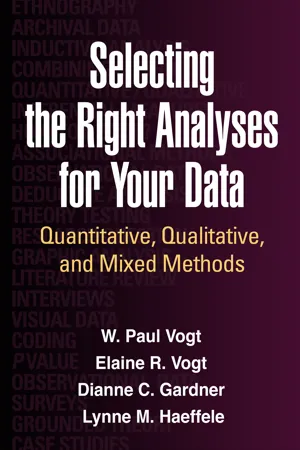
eBook - PDF
Selecting the Right Analyses for Your Data
Quantitative, Qualitative, and Mixed Methods
- 500 pages
- English
- PDF
- Available on iOS & Android
eBook - PDF
Selecting the Right Analyses for Your Data
Quantitative, Qualitative, and Mixed Methods
About this book
What are the most effective methods to code and analyze data for a particular study? This thoughtful and engaging book reviews the selection criteria for coding and analyzing any set of data--whether qualitative, quantitative, mixed, or visual. The authors systematically explain when to use verbal, numerical, graphic, or combined codes, and when to use qualitative, quantitative, graphic, or mixed-methods modes of analysis. Chapters on each topic are organized so that researchers can read them sequentially or can easily "flip and find" answers to specific questions. Nontechnical discussions of cutting-edge approaches--illustrated with real-world examples--emphasize how to choose (rather than how to implement) the various analyses. The book shows how using the right analysis methods leads to more justifiable conclusions and more persuasive presentations of research results.
User-Friendly Features
*Chapter-opening preview boxes that highlight useful topics addressed.
*End-of-chapter summary tables recapping the 'dos and don'ts' and advantages and disadvantages of each analytic technique.
*Annotated suggestions for further reading and technical resources on each topic.
See also Vogt et al.'s When to Use What Research Design, which addresses the design and sampling decisions that occur prior to data collection.
User-Friendly Features
*Chapter-opening preview boxes that highlight useful topics addressed.
*End-of-chapter summary tables recapping the 'dos and don'ts' and advantages and disadvantages of each analytic technique.
*Annotated suggestions for further reading and technical resources on each topic.
See also Vogt et al.'s When to Use What Research Design, which addresses the design and sampling decisions that occur prior to data collection.
Frequently asked questions
Yes, you can cancel anytime from the Subscription tab in your account settings on the Perlego website. Your subscription will stay active until the end of your current billing period. Learn how to cancel your subscription.
At the moment all of our mobile-responsive ePub books are available to download via the app. Most of our PDFs are also available to download and we're working on making the final remaining ones downloadable now. Learn more here.
Perlego offers two plans: Essential and Complete
- Essential is ideal for learners and professionals who enjoy exploring a wide range of subjects. Access the Essential Library with 800,000+ trusted titles and best-sellers across business, personal growth, and the humanities. Includes unlimited reading time and Standard Read Aloud voice.
- Complete: Perfect for advanced learners and researchers needing full, unrestricted access. Unlock 1.4M+ books across hundreds of subjects, including academic and specialized titles. The Complete Plan also includes advanced features like Premium Read Aloud and Research Assistant.
We are an online textbook subscription service, where you can get access to an entire online library for less than the price of a single book per month. With over 1 million books across 1000+ topics, we’ve got you covered! Learn more here.
Look out for the read-aloud symbol on your next book to see if you can listen to it. The read-aloud tool reads text aloud for you, highlighting the text as it is being read. You can pause it, speed it up and slow it down. Learn more here.
Yes! You can use the Perlego app on both iOS or Android devices to read anytime, anywhere — even offline. Perfect for commutes or when you’re on the go.
Please note we cannot support devices running on iOS 13 and Android 7 or earlier. Learn more about using the app.
Please note we cannot support devices running on iOS 13 and Android 7 or earlier. Learn more about using the app.
Yes, you can access Selecting the Right Analyses for Your Data by W. Paul Vogt,Elaine R. Vogt,Dianne C. Gardner,Lynne M. Haeffele in PDF and/or ePUB format, as well as other popular books in Social Sciences & R&D. We have over one million books available in our catalogue for you to explore.
Information
Table of contents
- Cover
- Half Title Page
- Title Page
- Copyright Page
- Preface and Acknowledgments
- Abbreviations Used in This Book
- Extended Contents
- General Introduction
- Part I. Coding Data—by Design
- Part II. Analysis and Interpretation of Quantitative Data
- Part III. Analysis and Interpretation of Qualitative and Combined/Mixed Data
- References
- Index
- About the Authors